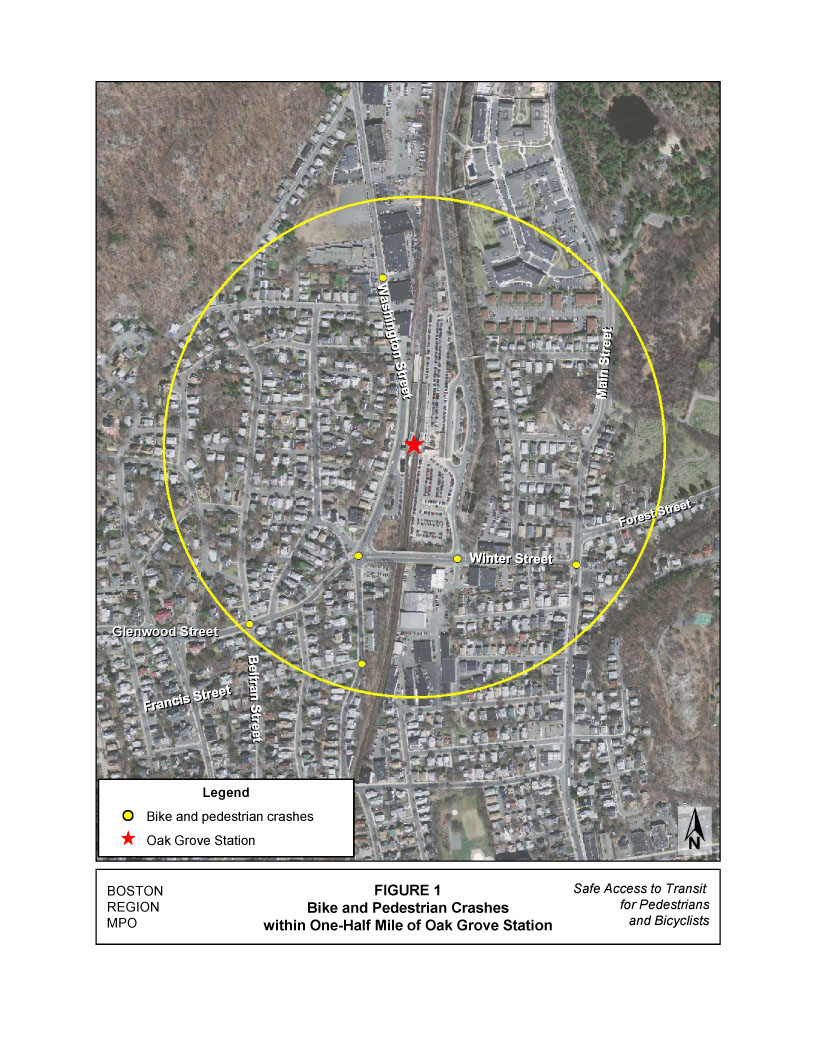
MEMORANDUM
DATE December 6, 2012
TO Boston Region Metropolitan Planning Organization
FROM Mark Abbott, Christine Bettin, and Bill Kuttner
MPO Staff
RE Safe Access to Transit for Pedestrians and Bicycles: Oak Grove Station
Oak Grove Station is located on Washington Street at Winter Street in Malden, immediately south of the Malden-Melrose boundary. Oak Grove Station was selected to be included in the Boston Region Metropolitan Planning Organization (MPO) Safe Access to Transit for Pedestrians and Bicyclists Study. This study examines nonmotorized accessibility issues related to Oak Grove Station and identifies short- and long-term measures that can significantly improve pedestrian and bicyclist access to the Massachusetts Bay Transportation Authority (MBTA) system. Oak Grove Station was selected based on the following factors:
Oak Grove Station is the northern terminus of the MBTA’s Orange Line, which is a heavy rail line. It was opened in 1977 as part of the Haymarket North Project, which relocated the Orange Line north of Haymarket Station to a new corridor paralleling the Haverhill commuter rail line. Oak Grove was the north most station and marked the completion of the project.
Oak Grove Station lies within a north-south transportation corridor connecting Malden and Melrose that is bounded by parks to the west and east—the Middlesex Fells Reservation to the west, and the Pine Banks Park and Forest Dale Cemetery to the east. The Orange Line shares the MBTA rail corridor with the Haverhill commuter rail line. Most commuter trains stop at Malden Center and then make three stops in Melrose, including the southernmost stop, Wyoming Hill, which is one mile north of Oak Grove. MBTA bus Routes 131, 132, 136, and 137 make regular stops at Oak Grove Station. Routes 131, 136, and 137 travel along Main Street, which parallels the rail corridor to the east. Route 132 travels along Washington Street, which parallels the rail corridor to the west. The average number of weekday boardings and alightings for these bus routes at Oak Grove Station are provided in Table 1.3 Maps for Routes 131, 132, 136, and 137 are provided in the Appendix.
Table 1
Average Weekday Boardings and
Alightings at Oak Grove Station
|
Inbound |
Outbound |
||
Bus Route |
On |
Off |
On |
Off |
131 |
0 |
248 |
286 |
1 |
132 |
0 |
262 |
118 |
7 |
136 |
3 |
426 |
250 |
13 |
137 |
11 |
309 |
223 |
13 |
Land use patterns in the Malden part of the station area have been stable for some time, with light industry adjacent to the rail corridor and small-parcel single- and two- family homes in the nearby neighborhoods. In contrast, there have been important changes on the Melrose side of the station. Historic brick mill buildings west of the rail corridor are now used by light industry. There is a development project under construction north of Oak Grove Station. Also, a newly built, mixed-use housing development lies east of the rail corridor. A pedestrian bridge and pathway connect this housing development to the eastern side of the transit station. In a study conducted by the Metropolitan Area Planning Council (MAPC), Washington Street, from Oak Grove Station north into Melrose, is identified as a potential bicycle route.4
Records available to Boston Region MPO staff show that there have been a total of seven bicycle or pedestrian crashes from 2005 to 2009 at six locations within a half-mile of Oak Grove Station (Table 2). Of the seven crashes involving a bicycle or pedestrian, two were at the same intersection and one was at a location best characterized as a driveway (Glen Rock Road). Figure 1 illustrates the locations of the bicycle and pedestrian crashes in proximity to Oak Grove Station.
Table 2
Intersections within One-Half Mile of Oak Grove Station with
Pedestrian or Bicycle Crashes from 2005 to 2009
Intersection |
City/Town |
Vehicle Crashes |
Pedestrian Crashes |
Bicycle Crashes |
Total Crashes |
Glen Rock Road/ Washington Street (Driveway) |
Malden |
2 |
0 |
1 |
3 |
Glenwood Street/Beltran Street |
Malden |
4 |
1 |
0 |
5 |
Francis Street/Washington Street |
Malden |
2 |
1 |
0 |
3 |
Glenwood Street/Grove Street/ Washington Street/Winter Street |
Malden |
11 |
1 |
1 |
13 |
Banks Place/Winter Street |
Malden |
0 |
1 |
0 |
1 |
Main Street/Forest Street/ Winter Street |
Malden |
9 |
1 |
0 |
10 |

Five of those six locations, excluding Glen Rock Road at Washington Street, were selected for further analysis (see Figure 2). The five intersections are:
This section describes the existing conditions and recommended improvements for the five identified problem intersections. The description of existing conditions is based on a site visit conducted on Friday, August 3, 2012, during the early afternoon. The recommended improvements are either short- or long-term in nature and were devised in order to help alleviate the concerns and issues identified during the site visit. The short-term recommendations would primarily consist of the installation of signs and pavement markings, which may be implementable within a short time frame with local resources. Long-term recommendations would require more capital-intensive roadway construction, which would necessitate the identification and allocation of resources and entail a longer implementation schedule.
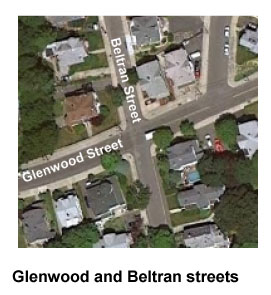
There were five crashes, including one with a pedestrian, at the intersection of Glenwood Street and Beltran Street, which is located three blocks southwest of Oak Grove Station. Glenwood Street is a two-lane, east-west road with moderate traffic volumes and speeds observed during the site visit. Beltran Street has stop signs on both approaches to Glenwood Street, and low traffic volumes and speeds were observed. No trucks were observed at this intersection during the site visit.
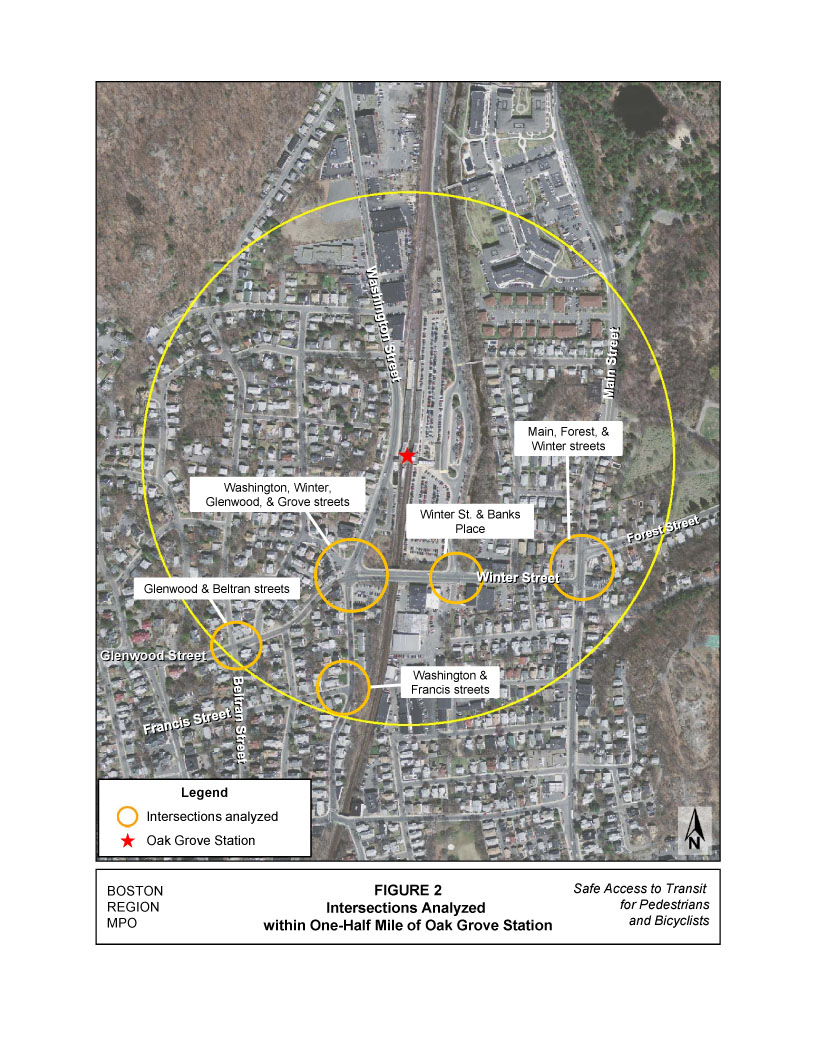
Beltran Street rises on one approach, limiting visibility, and the word “stop” appears twice on the stop sign for emphasis. Stop bars are not painted in advance of the stop signs. A “Slow Please” traffic sign has been placed on the northwest corner of the intersection.
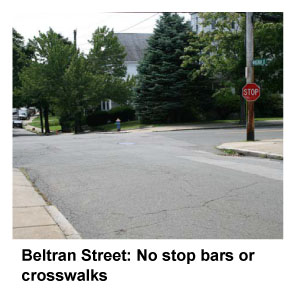
The sidewalks along Glenwood Street are wide and in fair condition, although a few areas are bumpy. There are pedestrian curb-cut ramps at each corner of the intersection, although one ramp is a driveway. The ramps are slightly tilted because they follow the Beltran Street grade.
A main issue at this intersection is lack of visibility, since vehicles approaching from each leg must process information regarding grade and curvature, in addition to observing traffic, pedestrians, and bicycles. There are no bicycle-specific features at this intersection.
The following recommendations would improve visibility between the various right-of-way users at this intersection.
Pedestrian Improvements
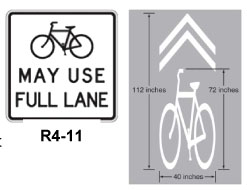
Bicycle Improvements
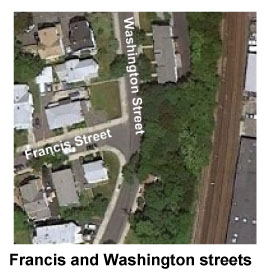
There were three crashes, including one with a pedestrian, at the intersection of Francis Street and Washington Street. Francis Street meets Washington Street at a “T” intersection two blocks south of Oak Grove Station. Washington Street approaches the station, has no center stripe, and had light traffic when observed during the site visit. No traffic was observed on Francis Street, and there is no stop sign. Traffic speeds were moderate and appropriate for the street. Bus Route 132 operates on Washington Street, and there are stops in both directions at Francis Street. No trucks were observed.

There is a large root bump under the sidewalk on the east side of Washington Street. There are no bicycle-specific features at this intersection.
Grade and curvature have a minor impact on visibility at this location. A potential impact on sight distance may be a tall, privately owned wooden fence along the property line of the residence on the northwest corner of the intersection.
The following recommendations would improve visibility between the various right-of-way users at this intersection.
Pedestrian Improvements
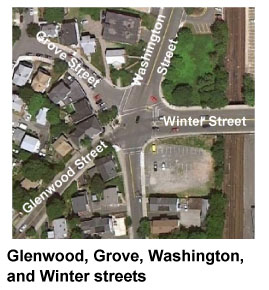
Washington Street is a minor arterial roadway that meets Winter Street to the east and Grove and Glenwood streets to the west, creating a five-leg, skewed intersection. There was one bicycle crash and one pedestrian crash at this intersection between 2005 and 2009. During the site visit, traffic flows and speeds appeared to be moderate along all intersecting roadways.
All legs of the intersection, except Grove Street, which is a westbound one-way street, are signalized. There are pedestrian signals for the south and southwest legs of this intersection, where push buttons activate a dedicated pedestrian phase for all legs of the intersection at the same time. The pedestrian signal timing is 22 seconds, which is sufficient for the lengths of crossings at this intersection.
The sidewalks range from approximately 6 to 8 feet in width; some of them are old and some are newly built. All corners of the intersection have pedestrian curb-cut ramps, although the ramps do not have detectable warning pads.
There is a channelizing and pedestrian refuge island across Washington Street; however, the pedestrian crossing distance from the island to the west side of the street is approximately 60 feet. The longest uninterrupted crossing a pedestrian should encounter at a crosswalk is 50 feet.5 Motorists wishing to enter Grove Street from Winter Street were observed to travel in both directions around the channelizing and pedestrian refuge island.
Grove Street intersects with Washington, Glenwood, and Winter streets at a skewed angle. It is a low-volume, westbound one-way, one-lane road that is approximately 40 feet wide at the intersection, after which its width decreases to approximately 30 feet. Grove Street approaches the intersection between Washington Street and Glenwood Street, which creates poor visibility between motorists making right turns from Washington Street onto Glenwood Street and pedestrians standing on the northwest corner of Glenwood Street and Washington Street. Additionally, visibility at this corner is blocked by vegetation, a traffic signal post, and a utility post.
The corner radius on the northwest corner of Grove Street and Washington Street appears to be large, which increases the pedestrian crossing distance and may increase the speed of turning vehicles.
There are no bicycle-specific features within this intersection.
The following short-term recommendations would improve visibility between the various right-of-way users at this intersection.
Pedestrian Improvements
Bicycle Improvements
The following long-term recommendations would improve visibility between the various right-of-way users at this intersection.
Pedestrian Improvements
Bicycle Improvements
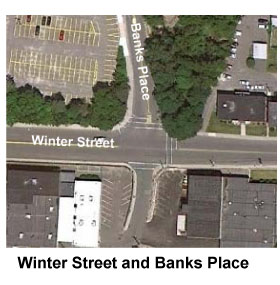
The Oak Grove Station has extensive parking arrayed to the east and south of the head-house and station platforms. Banks Place connects the station parking lots with Winter Street, an east-west street immediately south of the station property. Winter Street has traffic signals at both ends—where it meets Washington Street to the west and Main Street to the east. During a site visit at around noon on Friday, August 3, traffic on Winter Street was moderate and included some trucks. Speeds were appropriate for the roadway.
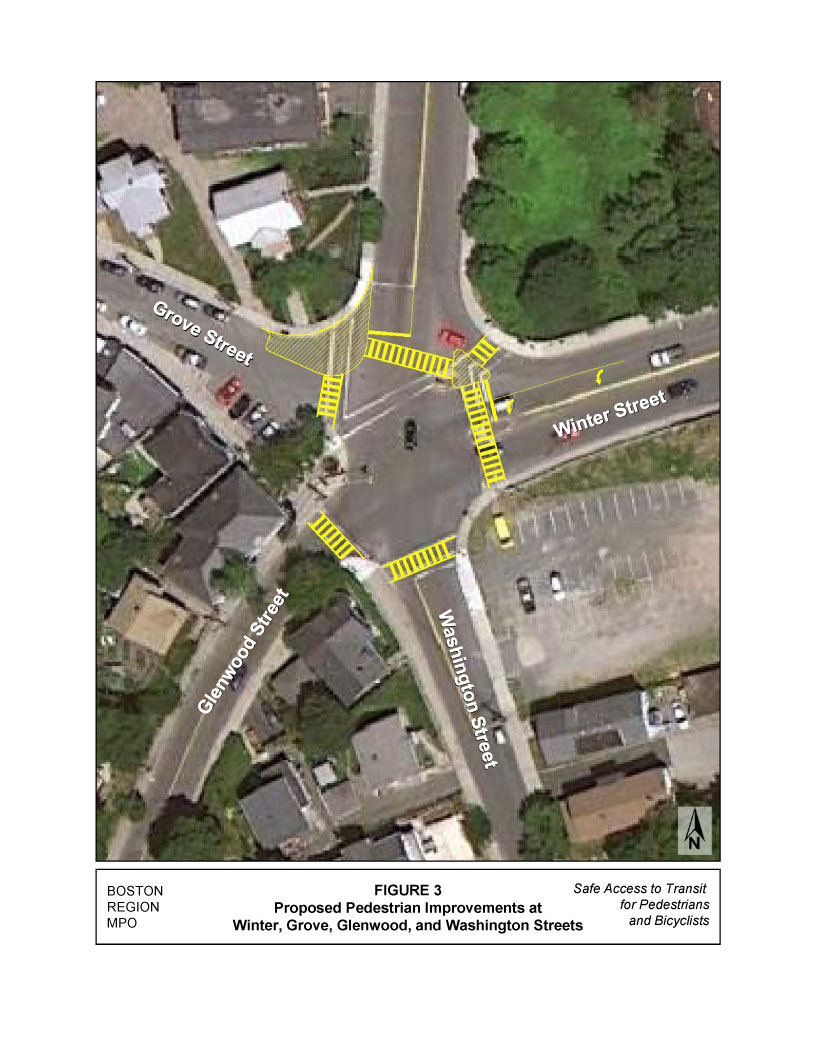
Banks Place has a stop sign as it approaches Winter Street. Across the street is a private way leading into a small industrial park, and this private way also has a stop sign where it meets Winter Street. During the site visit, no traffic to Oak Grove Station was observed, and a small amount of traffic was seen entering or leaving the industrial park. There appear to have been traffic signals at this intersection at one time. The masts remain, but the signal heads have been removed.
Banks Place has two generous lanes separated by a yellow line, and has a small traffic island where it meets Winter Street, where there are a crosswalk and stop-line. The road into the industrial park is narrow and has no striping. Winter Street has two wide lanes in each direction east of the intersection, but west of the intersection it widens to accommodate two narrow westbound lanes as it approaches Washington Street. Unfortunately, these lane markings are now almost invisible. There are no bicycle-specific features at this intersection.
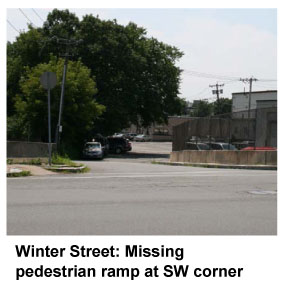
The sidewalks at this intersection are almost entirely inadequate. Winter Street, the public way, has usable sidewalks and ramps along its north side. On the south side, the sidewalks are variously narrow, obstructed, or lacking ramps. Pedestrians going to the industrial park must walk in the street, and Banks Place, the access road to Oak Grove Station, only has a sidewalk on the west side.
Three approaches to this intersection have painted crosswalks. There is no crosswalk across the west leg of this intersection. There is a painted crosswalk with a Yield to Pedestrians sign on a stanchion across Winter Street on the east side of the intersection.
The following short-term recommendations would improve visibility between the various right-of-way users at this intersection.
Pedestrian Improvements
Bicycle Improvements
The following long-term recommendations would improve visibility between the various right-of-way users at this intersection.
Pedestrian Improvements
Bicycle Improvements
Main Street is a busy north-south arterial that meets Winter Street to the west and Forest Street to the east at a pair of “T” intersections offset by 160 feet. During the site visit, traffic was heavy on Main Street and included numerous trucks, and was moderate on Winter and Forest streets. Traffic speeds were moderate and appropriate for the intersection.
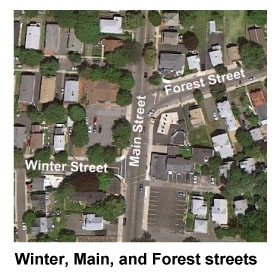
Both intersections are signalized, and the signals are timed to function as a single intersection. Traffic approaching from the west on Winter Street receives an exclusive green phase, allowing movement to the north or south on Main Street, or to the east with a second turn onto Forest Street. This is followed by a green phase for Main Street. Then there is an exclusive green phase for westbound traffic on Forest Street that allows movement to the north or south on Main Street, or to the west with a second turn onto Winter Street. There is another green phase for Main Street before Winter Street receives its next green. Right turns on red are permitted.
There are three striped crosswalks: one each across Winter and Forest streets, and one across Main Street south of Winter Street. The lack of a crosswalk on the north leg of the intersection requires pedestrians on the northeast corner to cross three signalized crosswalks, potentially over the course of three signal cycles, to get to the northwest corner of Winter and Main streets on a path to Oak Grove Station.
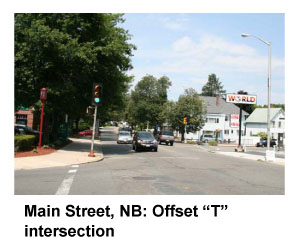
Push buttons are available at each crosswalk location, and pushing a button results in a dedicated pedestrian phase over the two offset intersections. The pedestrian signal timing provides 23 seconds of crossing time for pedestrians, which is sufficient. The pedestrian signal heads on the northwest and southwest corners of Main and Winter Streets were not functioning properly, and the pedestrian signal push button on the northeast corner of Main and Forest Streets was not functioning properly. There are no bicycle-specific features.
The sidewalks are wide; some are old and some are newly built. One corner lacks a pedestrian curb-cut ramp, requiring the use of a nearby driveway. The sidewalks along the 160-foot offset section have curb cuts that allow vehicle access to a bank branch on the west and a gas station on the east side of the intersection.
The following short-term recommendations would improve visibility between the various right-of-way users at this intersection.
Pedestrian Improvements
Bicycle Improvements
The following long-term recommendations would improve visibility between the various right-of-way users at this intersection.
Pedestrian Improvements
Bicycle Improvements
The recommendations provided in this study aim to improve accessibility to the Oak Grove Station from surrounding neighborhoods for pedestrians and bicyclists. If implemented, these recommendations would provide pedestrians and bicyclists with safer and more convenient paths to Oak Grove Station.
The recommendations are either short-term, low-cost, and quick to implement, or are long-term and would require a more intensive capital investment with a longer implementation schedule. Short-term improvements recommended in this study include restriping pavement markings and crosswalks, installing pedestrian signage, installing ADA-compliant improvements, striping bike lanes and/or using shared-lane markings, trimming vegetation, improving lighting, and repairing pedestrian signals. These types of improvements would improve visibility between pedestrians, bicyclists, and motorists, indicate where these users should travel within the right-of-way (ROW), and provide a safer and more convenient environment.
The long-term improvements recommended in this study include constructing curb extensions and curb ramps, installing pedestrian signals, and identifying a bicycle route through the industrial park. These types of improvements would more effectively increase visibility between pedestrians, bicyclists, and motorists, as well as helping to reduce vehicle speeds and minimize crossing distances for pedestrians, than the short-term improvements.
A previous study conducted by MAPC proposed creating bike routes along Washington Street and Banks Place, terminating at Oak Grove Station. 6 These proposed bike routes would provide an improved connection for bicyclists traveling south to Oak Grove Station. In order to accommodate bicyclists traveling east to Oak Grove Station, it is recommended that a bike route along Glenwood and Winter streets and then north along Banks Place be installed. This would provide bicyclists a direct connection to the newly constructed Pedal & Park bike cage, which is located on the east side of Oak Grove Station. For bicyclists traveling north to Oak Grove Station, there may be potential to create a bicycle route along Linden Avenue and through the industrial park to Banks Place. This would provide a north-south connection on a road parallel to Main Street, which has a constrained ROW and heavy traffic. For bicyclists traveling west to Oak Grove Station, a bicycle route along Forest Street to Winter Street and then north along Banks Place is recommended. Please see the Appendix for a map of the proposed bike routes in the vicinity of Oak Grove Station.
Implementing the recommendations in this study would improve the roadways used by pedestrians and bicyclists accessing Oak Grove Station. This may encourage more users of Oak Grove Station to choose bicycling and walking as modes of transportation, and may also promote the use of public transit. This, in turn, may shift users from personal vehicles, which may also help reduce the strain on commuter parking at Oak Grove Station, which is consistently at capacity (99% utilization). Reducing the demand for parking at Oak Grove Station is a more cost-effective solution than constructing additional parking spaces. Overall, through the implementation of these recommendations, the Town of Malden would improve access to safe, healthy, efficient, and varied transportation options for its residents and visitors.
MSA/WSK/CB/cb
Routes 131/132 Map
Routes 136/137 Map

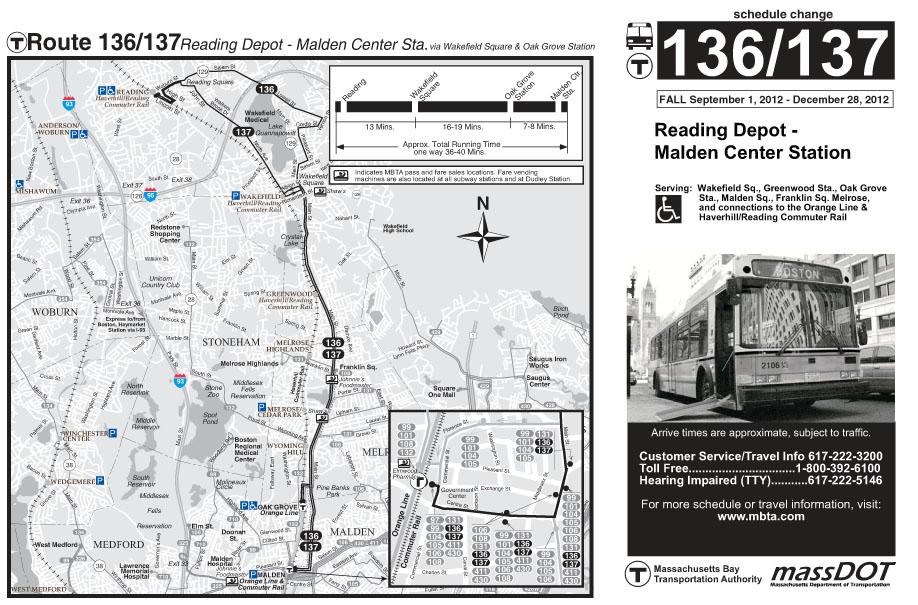

General Recommendations
Overall, none of the study locations have issues that seriously impede the access of pedestrians and bicyclists to a transit station. However, general maintenance issues should be addressed in all of the study areas. In addition, conditions and facilities could be further improved in order to enhance the safety and quality of pedestrian or bicyclist access; best-practices guidelines should be consulted and applied when possible.
Maintenance of Existing Facilities and Amenities
In each of the study areas, many of the existing facilities and amenities are in need of repair or upkeep. Faded crosswalk paint, uneven and broken pavement surfaces on sidewalks and roadways, malfunctioning pedestrian signals, and malfunctioning streetlamps are examples of facilities and amenities that are in need of attention. At a minimum, these should be in good, functional condition.
Seasonal Maintenance
Another condition commonly found at many study locations is a need for regular and seasonal upkeep of sidewalks and roadways. Dirt, sand, and debris accumulate in the gutters of roads and on sidewalks, particularly during and after the winter season. The winter also presents the issue of snow and ice, which are often piled onto sidewalks and along the sides of roads. In the summer, weeds and overgrown plants can obstruct pedestrian and bicyclist movement. Aside from being unpleasant and a nuisance, these conditions create obstructions that may make travel hazardous and impede transit patrons from easily using the MBTA system.
Sidewalks
It is important to provide a continuous and accessible network of sidewalks along walking routes to MBTA stations, particularly for pedestrians with disabilities. When a sidewalk is provided on only one side of a roadway, pedestrians often walk in the street or cross at unmarked midblock locations. Sidewalk surfaces should be level, smooth, and without obstructions in the pathway of pedestrians. In addition, best-practices guidelines recommend a buffer between the sidewalk and the roadway. However, on most of the streets in the study areas, roadway widths may not permit this feature.
In a few locations, the sidewalks do not have a curb-cut wheelchair ramp at crosswalks. Also at some locations, sidewalks have diagonal (apex) curb ramps, where only one ramp is provided at a street corner; these ramps typically are not aligned with the marked crosswalks. Diagonal curb ramps are the predominant type used in the study areas; however, this type of curb ramp is not recommended by current Federal Highway Administration best-practices guidelines. Instead, street corners should have two curb ramps, one aligned with one street’s crosswalk and the other aligned with the other street’s crosswalk (see the diagram at the left). For additional safety, the bottom of the ramps should have a detectable warming strip.
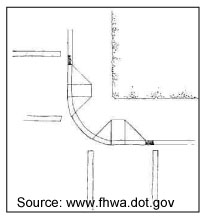
Crosswalks
The crosswalks in the study areas generally are striped with basic markings, very few of which are marked in a manner that goes above and beyond the Manual on Uniform Traffic Control Devices (MUTCD) standards. Typically, they are striped with two parallel solid white lines or have a ladder-style marking. In most cases, the stop line for vehicle traffic is too close to the crosswalk.
Best-practices guidelines recommend that crosswalks be well marked and accentuated by curb extensions. This study recommends, at a minimum, marking sidewalks with ladder-style striping. A 10-foot distance between the stop lines and crosswalks is recommended. Treatments for multilane roadways should include a 10-to-30-foot distance between the stop line and the crosswalk, pedestrian refuge islands/medians, and curb extensions for increased visibility of pedestrians. Also, this study recommends appropriate signs to warn motorists of pedestrian crossing activity.
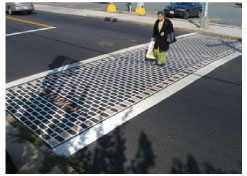
In order to improve sight lines between motorists and crossing pedestrians, on-street parking should be spaced at least 30 feet back from crosswalks. Furthermore, other innovative options for enhancing crosswalks should be considered, including the use of reflective paint or thermoplastic striping, pavement texturing (see photo, at left), in-pavement lights, crosswalk cones and barrels, and overhead signs.

Signalized Pedestrian Crosswalks
Some signalized pedestrian crossings in the study area have malfunctioning signals and buttons. As a first step, all existing signals should have functioning buttons and walk signals. Moreover, the crossings should be enhanced with more modern signal technology. For example, signals should be equipped with pedestrian activation buttons that light up when pushed, as an indication of having been successfully activated. Also, countdown-style pedestrian crossing signals (see photo, at left) should be used in places with a sufficient amount of pedestrian activity to warrant them.
Intersection Safety
Several intersections in the study areas should be made safer for pedestrians and bicyclists through some minor redesign. (An example of a possible redesign is shown in a photo below, from the website www.pedbikeimages.org/DanBurden.) Curb extensions at the corners, for instance, create a tighter turning radius for vehicles, which slows the speed of traffic at turns. Curb extensions also provide better sight lines for motorists to watch for pedestrians and vice versa. Furthermore, medians and islands can be enlarged to better guide and control traffic, often slowing vehicle speeds as well. Medians and traffic islands should be large and visible enough to provide sufficient refuge for pedestrians. Plus, striping should be clear and delineate the vehicle turning lanes, the crosswalks, and the stop lines. Lastly, intersections with significant pedestrian activity could be marked as a pedestrian crossing zone (instead of having only crosswalks), where an all-red pedestrian phase is part of the signal cycle.
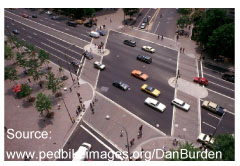
On-Street Bicycling
On many roads that lead to transit stations, bicyclists must contend with high traffic volumes and on-street parking. High traffic volumes, particularly when combined with high speeds and frequent turning movements, can be intimidating to bicyclists. Traffic-calming measures that reduce vehicle speeds can be implemented to help reduce both the severity and incidence of motor vehicle crashes with bicycles, and can also make bicyclists feel more comfortable while riding along roadways. On-street parking poses challenges in the form of conflicts between vehicles that are parking or discharging passengers, and bicyclists, who are often negotiating traffic to their left in addition to coping with the parked-vehicle activity to their right.
Roadway design and condition are also issues for bicyclists. Narrow lanes and narrow shoulders are a concern, particularly on roads with high traffic volumes. Potholes and poor pavement should be fixed, as bicyclists are more sensitive to pavement conditions than are motorists. Storm-sewer grates should be either grids or parallel bars appropriately placed perpendicular to traffic flow.
There are different types of on-street bicycle facilities that can be provided to improve safety for bicyclists, such as cycle tracks, buffered bike lanes, bike lanes, shared lanes, paved shoulders, and signed routes. Further study of the availability of right-of-way, roadway conditions and bicycle traffic volumes should be conducted in order to determine the type of on-street bicycle facility that would be appropriate for a specific roadway.
Bicycle Parking
All of the stations studied provide bicycle racks. When selecting locations for the installation of bicycle racks, it is important to consider visibility, lighting conditions, protection from the elements, and proximity to destinations. Additionally, racks should be situated in spots that offer enough space not only for storing bicycles, but also for maneuvering them. If bicycle racks or cages are located in an area not easily seen by bicyclists, then directional signage should be considered.
Current bicycle parking guidelines7 recommend that providers of bicycle racks select types that:
Common styles of bicycle parking racks that meet the above guidelines include: the inverted-U or hoop (see photo to left), “A” (a hoop with a horizontal bar), and post-and-loop (also known as bike hitch). Many manufacturers produce these or acceptable variations of these styles. These rack elements are typically arranged in a row or array; the spacing between the rack elements should be a minimum of 30 inches (on centers), but preferably a more comfortable 36 to 42 inches.
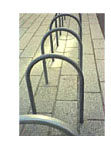
Signs: Wayfinding for Transit Stations
Well-placed wayfinding signs—pointing the way to a transit station—reach out to potential riders. They are similar in function to signs that direct motorists to highway ramps. Care should be taken to install the signs at a height and orientation favorable to pedestrians. Also, these signs should use conventional MBTA symbols, lettering, and colors.
Travel Environment
The aesthetic look and feel of the travel environment can encourage use by pedestrians and bicyclists. Communities should implement measures to improve the quality of the street environment through the use of landscaping (trees, shrubs, and flowers, all appropriately placed), lighting, furniture (such as benches and trashcans), and artwork (such as sculptures and murals). Chambers of commerce and business owners should also be encouraged to enhance storefronts and streetscapes.
Future Considerations
The opportunity to implement many of the recommended improvements may only arise when a roadway construction project occurs. Any roadway construction project should apply best-practices guidelines for serving pedestrian and bicyclist travel in general. More specifically, projects should improve walk and bike access to transit stops and stations as much as possible. In essence, the MBTA, the MassDOT Highway Division, local governments, and land developers should coordinate and cooperate on all transportation improvement projects to ensure that pedestrian and bicyclist needs are integrated into the final designs.
When improvements are made to the accessibility of transit for pedestrians and bicyclists, they can be highlighted in public information campaigns promoting the option of bicycling to transit stations. The improved accessibility can be extolled, along with the cost, time, and health benefits to individuals.
1 Boston Region Metropolitan Planning Organization, Needs Assessment (Volume 2 of Paths to a Sustainable Region), prepared by the Central Transportation Planning Staff, September 27, 2011.
2 Boston Region Metropolitan Planning Organization, MBTA Systemwide Passenger Survey, prepared by the Central Transportation Planning Staff, May 19, 2010.
3 MBTA Ridecheck Program; spring 2009 and winter 2010.
4 Metropolitan Area Planning Council, “Main Street Corridor Study,” January 2012.
5 Massachusetts Highway Department. Project Development and Design Guide, Massachusetts Department of Transportation, January 2006
6 Metropolitan Area Planning Council, Main Street Corridor Study, January 2012.
7 One reference is Bicycle Parking Guidelines (2002), adopted by the Association of Pedestrian and Bicycle Professionals. For more information, please refer to www.bicyclinginfo.org/de/parkguide.htm.